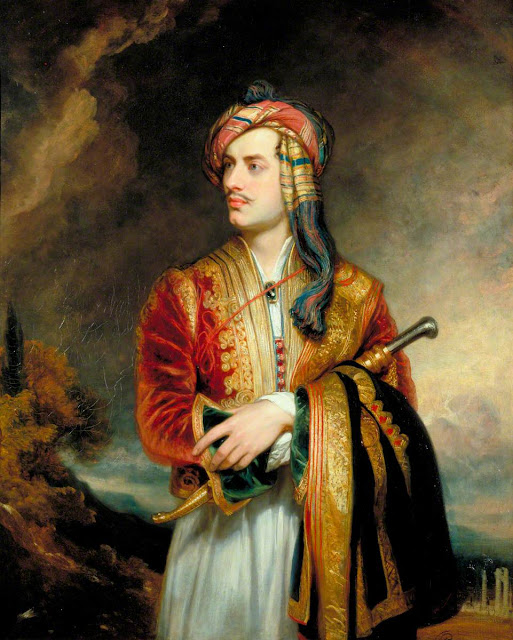Hunting the Ladies of the Raj: Part 2
This post carries on from a previous one at
https://budleighpastandpresent.blogspot.com/2015/07/hunting-ladies-of-raj-part-i.html
https://budleighpastandpresent.blogspot.com/2015/07/hunting-ladies-of-raj-part-i.html
Lord Byron in Albanian dress painted by Thomas Phillips in 1813. Venizelos Mansion, Athens (the British Ambassador's residence). Did he know any ladies of the Raj?
My
journalist visitor at Fairlynch Museum whom I mentioned previously was Mavis
Ellis. She seems to have specialised in writing on 19th century
subjects including Lord Byron, who is buried at the Church of St. Mary Magdalene in Hucknall near her home in
Nottinghamshire.
I
sent her up the hill to look at Umbrella Cottage, the home of Henry Carter, the
doctor, geologist and marine sponge expert who had spent so much of his working
life in 19th century India.
She
did not return to the Museum, so I imagine that she may have gone back to
Sidmouth, disappointed that the ladies
of the Raj had disappeared from Budleigh Salterton.
Had
she been a nerdy surfer like me she might have found, while researching 19th
century India, this link at http://centres.exeter.ac.uk/ws/Abstracts/AbKavanagh.html
Click on it and the answer will be 'Object not found'.
Click on it and the answer will be 'Object not found'.
That reference, to the summary of an MA University of Exeter
thesis, dated 1995, was one of many
hundreds that I’d chased up while researching Henry Carter’s years as a doctor in
Bombay. Excitingly, it was entitled ‘Women’s Tales of the Raj.’

A scene from life in the Raj
As I read the summary, I realised that the author, a Guinevere Mary Cavanagh, might have the answer as to where to find those Raj ladies of Budleigh Salterton.
“This dissertation,” explained the summary, “opens a window onto the lives and writing of the women of the British Raj. It evaluates the relationship between the white woman and newly colonized India.
By studying their journals it is possible to reconstruct their lives and to assess their role in the Colonial Scheme. The writing of the Mem Sahibs has been relegated to the peripheries of Imperialist culture and subsumed into an homogeneously patriarchal tradition. Immured within the archives of an Imperial adventure, their experiences have been ignored and their voices silenced.”

Keeping up appearances in the Raj
For with a bit more surfing the net I found that the author had been living almost opposite Fairlynch Museum, at 30 Fore Street. Born in 1920, she’d submitted her dissertation at the age of 75.
I read on.

Another domestic scene from life in India during British rule
“This study,” the abstract continues, “discloses a separate feminine experience of colonialism documented in journals and letters. These form a minute but important section of women's history yielding insights into their own perception of their roles. Women reacted to the strangeness and enormity of India in different ways. Some by simply replicating so far as possible the 'manners and customs' of life in the home country, remaining faithful to the prevailing norms of 'separate spheres'. Others found travel a liberating experience offering opportunities for the exercise of philanthropy by teaching or working in the mission field.
Women who by their presence in India under British rule were perforce complicit with colonialism, were not necessarily approving of it. Some endeavoured to ameliorate its harshness and all were obliged to negotiate their position as they constructed their 'other' from within the constraints of class and gender.”
Was Guinevere Mary Cavanagh ‘a lady of the Raj’ recommended to Mrs Ellis by the Indian professor at Bristol University?
Even
if she were not, it sounded to me as if her dissertation could have been based
on interviews with those ladies who had settled in Budleigh Salterton after
their years of living in India. As well as study of their diaries.
What had happened to Ms Cavanagh’s MA dissertation, I wondered? Had it been accepted? Where could one read it? Could it have provided material for Margaret MacMillan’s 2007 best-selling book Women of the Raj? Or Anne de Courcy’s equally popular 2013 book The Fishing Fleet about Husband-Hunting in the Raj.

I was a bit put out to discover that the online link to the dissertation summary no longer works. The helpful Exeter University librarian had not been able to locate it anywhere, and we had to assume that the dissertation itself had been discarded in the pre-digital age.
But here is a summary, which I found online a few years ago. It's now vanished from the internet.
Finally I found a Budleigh resident who remembered Guinevere Mary Cavanagh as a remarkable lady who had been a nurse during World War Two, or a member of the Dutch Resistance, or both – at any rate she spoke fluent Dutch, he recalled.
Sadly she had passed on. Nobody in Budleigh seems to know about her dissertation. Is it gathering dust on a shelf somewhere? Maybe in a relative's house? Or recycled as waste paper. That would be a shame. The summary looks fascinating.







Comments
Post a Comment